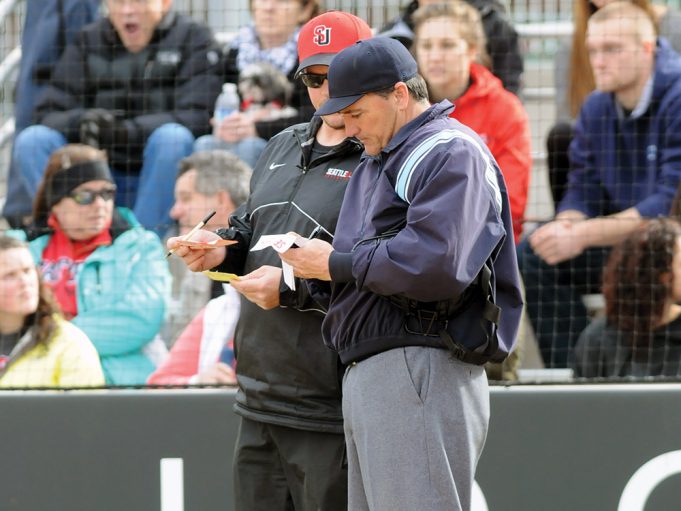In a game I worked last season, there were runners on second and third when the batter hit a little humpback liner over the second baseman’s head and dropped for a hit. The runner on third had gone back to tag up but scored easily. R2 was urged to round third base hard. The batter-runner rounded first as the right fielder made a strong throw to the cutoff person standing in the circle. R2, the runner that had rounded third, wanted to see if either the batter-runner was going to get played on or if she could draw a throw so the batter-runner could advance to second. The batter-runner was also watching to see if her teammate was going to be played on so she could advance or draw a throw herself in order to maybe score a run from third.
The problem was it was the pitcher who caught the ball in the circle. She was of similar build and stature as the first baseman with similar length hair and both were wearing a facemask. After a few seconds I recognized the player’s number and after hesitating verbalized, “That’s the pitcher with the ball.”
No other action immediately materialized so I called time and the runners went back to their bases. The offensive coaches didn’t realize right away it was the pitcher who had the ball and the defensive coach did not come out to question me. The play came during an NCAA D-III game so handling the situation the way I did worked. I’m sure I would’ve had to award an out for violation of the look-back rule at a higher level.
The look-back rule is in effect when the ball is live, the batter-runner has touched first base and the pitcher has possession and control of the ball within the circle. In the above case both runners were off and stopped. The effect is that the ball is dead and the offending runner is out. If two runners are off base and both are called out, the umpires must determine which runner was called out first since it not possible to obtain more than one out under the look-back rule.
In the college manual under look-back rule the above situation is addressed: “When a pitcher who is in the pitching circle receives a throw from the outfield, runners must be given the opportunity to locate the ball and realize it is the pitcher who has possession of the ball and that she is in the pitching circle.”
My problem was I could tell the runners and/or the offensive coaches never did realize it was the pitcher who had the ball and that is why I killed the play.
Better ways to handle the situation
Is there some way to better handle that situation? Should the offense be penalized because the defense doesn’t use the long-standing reaction to a hit in the outfield with runners in scoring position which has the pitcher back up either home or third in foul territory with the first baseman taking the cutoff to home from center and right?
One solution would be to have the pitcher wear a different color jersey or vest. Another and more realistic possible solution would be to have the pitcher be treated like an infielder when they are the cutoff person and not be afforded the look-back rule privileges. With a distinction of some sort, the umpire would recognize the pitcher is the cutoff and in the circle, could hesitate to make sure action is stopped and then kill the play with runners returning to their bases.
That seems like the most common sense approach to this situation. Granted most teams use their first baseman as the cut and many times the pitcher is distinguishable from her teammates. But the hard-and-fast look-back rule that causes the defense from a young age to yell “get the ball in the circle” should not be an advantage to the defense even with the vague advice to let the “runner realize it’s the pitcher.” I don’t think it’s fair to award the defense an “out” on a technicality.
What's Your Call? Leave a Comment:
Note: This article is archival in nature. Rules, interpretations, mechanics, philosophies and other information may or may not be correct for the current year.
This article is the copyright of ©Referee Enterprises, Inc., and may not be republished in whole or in part online, in print or in any capacity without expressed written permission from Referee. The article is made available for educational use by individuals.


















